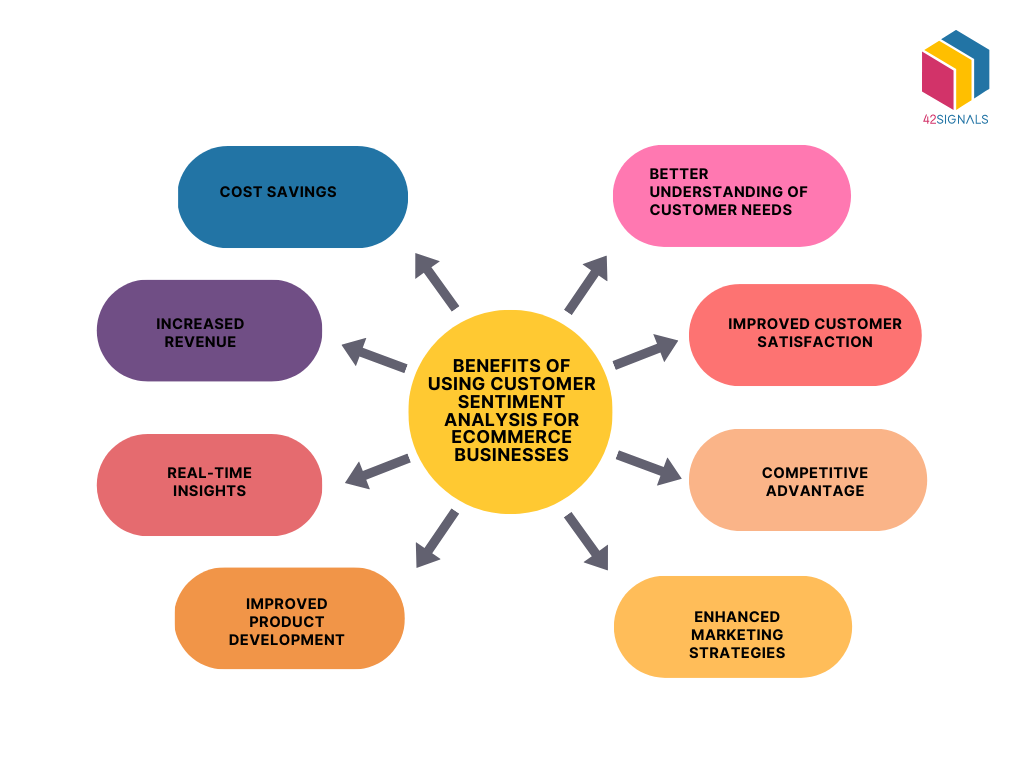In today’s hyper-connected world, ecommerce businesses are facing increasing competition to stand out and retain customers. To achieve this, businesses need to understand what their customers want and what they’re saying about their products and services. This is where customer review sentiment analysis comes in.
Customer Sentiment Analysis
Customer Sentiment Analysis is a technique used to identify and evaluate the opinions, attitudes, and emotions of customers towards a brand, product, or service. It involves analyzing text-based feedback such as customer reviews, social media posts, and surveys, to determine the overall sentiment towards a particular product or brand. Sentiment analysis uses natural language processing (NLP) and machine learning algorithms to classify text into positive, negative, or neutral sentiments. Businesses can gain valuable insights into how their customers perceive their brand and make data-driven decisions to improve customer satisfaction and retention, by analysing consumer sentiments. Sentiment analysis can also help businesses identify emerging trends, evaluate the effectiveness of marketing campaigns, and monitor brand reputation in real-time.
Let’s say a clothing retailer receives customer reviews for a new line of summer dresses. The reviews are analyzed using sentiment analysis software, which categorizes them into positive, negative, or neutral sentiments.
Example reviews:
- “I absolutely love this dress! It’s perfect for summer and fits like a dream.”
- “The design of this shirt is trendy and eye-catching, but the sizing is off.”
- “Meh, this dress is okay. It’s nothing special, but it’ll do.”
Based on the sentiment analysis, the clothing retailer can see that the majority of customers have a positive sentiment towards the dresses, but there are some concerns about the fabric. The retailer can use this information to make data-driven decisions to improve the product, such as sourcing softer fabrics or offering more color options. This can ultimately lead to improved customer satisfaction and higher sales.
Role of Consumer Sentiment Analysis in eCommerce
In today’s highly competitive eCommerce landscape, understanding the needs and preferences of customers is essential for success. Consumer sentiment analysis provides businesses with a powerful tool for gaining insight into customer feedback and perceptions. By leveraging sentiment analysis techniques, businesses can gain a comprehensive understanding of the different types of sentiment expressed by customers towards their brand and products. This can help eCommerce businesses to identify areas for improvement, monitor their brand reputation, understand customer preferences, and evaluate the effectiveness of their marketing campaigns. Ultimately, sentiment analysis can provide eCommerce businesses with the data-driven insights they need to stay competitive, improve customer satisfaction, and build stronger customer relationships. As such, the role of consumer sentiment analysis in eCommerce cannot be overstated.
Let’s say that a mobile manufacturing company has just launched a new smartphone model. To evaluate how customers are responding to the new product, the company decides to conduct a sentiment analysis of customer feedback and reviews. The analysis reveals that customers are mostly positive about the phone’s camera and display, with many customers praising the high-quality photos and clear screen. However, the analysis also reveals that customers have a negative sentiment towards the phone’s battery life, with many customers complaining that the battery drains quickly. Armed with this information, the mobile manufacturing company can make informed decisions to improve the product and enhance the customer experience. For example, they may decide to focus on improving the battery life in the next version of the phone or provide customers with tips on how to optimize their battery usage. By using sentiment analysis to gain insights into customer perceptions of their product, the mobile manufacturing company can make data-driven decisions to improve the product and ultimately drive sales and customer satisfaction.
Understanding the Different Types of Customer Sentiment
Customer sentiment analysis involves identifying and evaluating different types of customer sentiment. Sentiment analysis algorithms typically categorize text-based feedback into three main types of sentiment: positive, negative, and neutral. Understanding these different types of sentiment is essential for eCommerce businesses, as it allows them to gain insights into how their customers perceive their brand and products.
Positive sentiment refers to customer feedback that expresses satisfaction, happiness, or praise towards a brand or product. Positive sentiment can be an indication of a strong brand reputation, excellent customer service, and high-quality products. Positive feedback can also help eCommerce businesses identify areas of strength that they can leverage to drive further growth and customer loyalty. For example, a positive sentiment might include a customer review that says, “This product is just what I was looking for, I love it!”
Negative sentiment refers to feedback that expresses dissatisfaction, disappointment, or frustration towards a brand or product. Negative sentiment can be an indication of areas where the business needs to improve, such as product quality, customer service, or logistics. Negative feedback can be valuable to eCommerce businesses as it provides opportunities to address issues and improve the customer experience. For example, a negative sentiment might include a customer review that says, “This product was a complete waste of money. It didn’t work as advertised.”
Neutral sentiment refers to feedback that expresses neither positive nor negative sentiment towards a brand or product. Neutral feedback may not provide as much insight as positive or negative feedback, but it can still be valuable for eCommerce businesses to understand customer sentiment and preferences. For example, a neutral sentiment might include a customer review that says, “This product was okay. It did the job, but there’s nothing special about it.”
By analyzing customer sentiment, eCommerce businesses can gain valuable insights into how customers perceive their brand and products. Positive sentiment can help businesses identify their strengths and capitalize on them, while negative sentiment can identify areas for improvement. Neutral sentiment can also provide insights into areas where customers may be indifferent or lukewarm towards a particular product or service. Understanding the different types of customer sentiment is essential for effective customer review sentiment analysis and can help businesses make data-driven decisions to improve the customer experience, build stronger customer relationships and retain its customers.
Benefits of Using Customer Sentiment Analysis for eCommerce Businesses
There are numerous benefits to using customer sentiment analysis for eCommerce businesses. Here are a few key ones:

- Better understanding of customer needs: Customer review sentiment analysis helps businesses gain a deeper understanding of their customers’ needs, preferences, and pain points. By analyzing customer feedback and reviews, businesses can identify areas where they need to improve their products or services, as well as areas where they are already meeting customer expectations.
- Improved customer satisfaction: By using sentiment analysis to address customer concerns and make improvements to their products or services, eCommerce businesses can enhance the customer experience and improve customer satisfaction. Satisfied customers have a higher likelihood of returning to make additional purchases and promoting the business to others.
- Competitive advantage: By leveraging sentiment analysis to gain insights into customer perceptions and preferences, eCommerce businesses can gain a competitive advantage over their rivals. They can use this information to differentiate themselves in the market and offer products and services that better meet the needs of their customers.
- Enhanced marketing strategies: Sentiment analysis can help businesses develop more effective marketing strategies. By analyzing customer sentiment towards different products, features, or campaigns, businesses can identify which ones are resonating with customers and adjust their marketing efforts accordingly.
- Improved product development: By using customer review sentiment analysis to understand customer feedback and identify common pain points or feature requests, eCommerce businesses can make data-driven decisions to improve their products or create new ones that cater to the requirements of their customers more effectively.
- Real-time insights: Sentiment analysis provides eCommerce businesses with real-time insights into customer feedback and sentiment, allowing them to quickly address any concerns or issues that arise. This helps to build trust with customers and improve overall customer satisfaction.
- Increased revenue: By using sentiment analysis to improve the customer experience and enhance customer satisfaction, eCommerce businesses can increase customer loyalty and retention, which can ultimately lead to increased revenue and profitability.
- Cost savings: Sentiment analysis can help businesses identify issues or concerns early on, which can prevent costly product recalls, customer churn, or negative brand reputation. By addressing these issues quickly, businesses can save money and avoid potential financial losses.
How to Collect and Analyze Customer Sentiment Data Across Multiple Channels
Collecting and analyzing customer sentiment data across multiple channels can be challenging for eCommerce businesses, but there are several tools and strategies that can help. Here are some steps eCommerce businesses can take:
- Identify relevant channels: eCommerce businesses should identify the channels where their customers are most likely to share feedback, such as social media, review sites, customer support emails, or chatbots.
- Use eCommerce analytics tools: There are several eCommerce analytics tools available that can help businesses collect and analyze customer sentiment data across multiple channels. These tools can monitor online conversations, customer reviews, and feedback in real-time and provide businesses with insights into customer sentiment.
- Use sentiment analysis software: Businesses can also use sentiment analysis software to automatically analyze customer feedback and classify it as positive, negative, or neutral. This can save time and resources and provide a more accurate and objective analysis of customer sentiment.
- Monitor customer feedback regularly: eCommerce businesses should monitor customer feedback regularly and respond promptly to any concerns or issues raised by customers. This helps to build trust with customers and improve overall customer satisfaction.
- Combine quantitative and qualitative data: eCommerce businesses should combine quantitative data, such as customer ratings and reviews, with qualitative data, such as customer feedback and comments, to gain a more complete understanding of customer sentiment.
By using eCommerce analytics tools and sentiment analysis software, businesses can collect and analyze customer sentiment data across multiple channels, allowing them to make data-driven decisions that enhance the customer experience and drive business growth.
Leveraging Customer Sentiment Analysis to Identify Product and Service Issues and Make Data-Driven Improvements
Leveraging customer sentiment analysis is an effective way for eCommerce businesses to identify product and service issues and make data-driven improvements. By collecting and analyzing customer feedback from various channels, businesses can gain insights into the pain points, preferences, and opinions of their customers. This can help businesses identify areas where their products or services are falling short and make data-driven decisions to improve them. For example, sentiment analysis may reveal that customers are consistently complaining about long shipping times or poor customer support. Armed with this information, businesses can take steps to improve these areas by optimizing their shipping processes, providing more training to customer support staff, or investing in new tools and technologies to enhance the customer experience. Ultimately, leveraging customer review sentiment analysis to identify product and service issues can lead to increased customer satisfaction, loyalty, and revenue for eCommerce businesses.
Case Studies and Examples of Successful Customer Sentiment Analysis Implementations in eCommerce
1. Nike
Nike has successfully implemented customer sentiment analysis to better understand its customers and improve its marketing strategy. By analyzing social media conversations and online reviews, Nike has been able to gain valuable insights into how customers feel about its products and brand. Using this data, Nike has been able to tailor its marketing campaigns to better resonate with its target audience and has even been able to identify potential areas for product improvement. By listening to customer feedback and adapting to their needs, Nike has been able to strengthen its brand and maintain its position as a top athletic apparel company.
2. Dove
Dove has successfully implemented customer review sentiment analysis as a part of its “Real Beauty Pledge” initiative. By listening to feedback from its customers, Dove has been able to better understand their needs and concerns related to beauty standards. This information has helped Dove to develop products and campaigns that promote real beauty and body positivity. Through sentiment analysis of social media and online reviews, Dove has also been able to identify areas for improvement and address any negative feedback. By demonstrating a commitment to listening and responding to its customers, Dove has built a strong and loyal customer base who appreciate the brand’s message of inclusivity and self-acceptance.
3. KFC
KFC has successfully implemented customer review sentiment analysis to enhance its customer experience and drive business growth. Using various tools, including social media analytics and natural language processing, KFC has been able to capture and analyze customer feedback and opinions about its products and services. By analyzing customer sentiment, KFC has been able to identify areas of strength and weakness, and make data-driven decisions to improve its menu offerings and marketing strategies. KFC has also been able to monitor its brand reputation and respond quickly to any negative feedback or complaints, resulting in improved customer satisfaction and loyalty. Overall, customer sentiment analysis has allowed KFC to better understand its customers’ preferences and needs, leading to more effective business strategies and better customer experiences.




